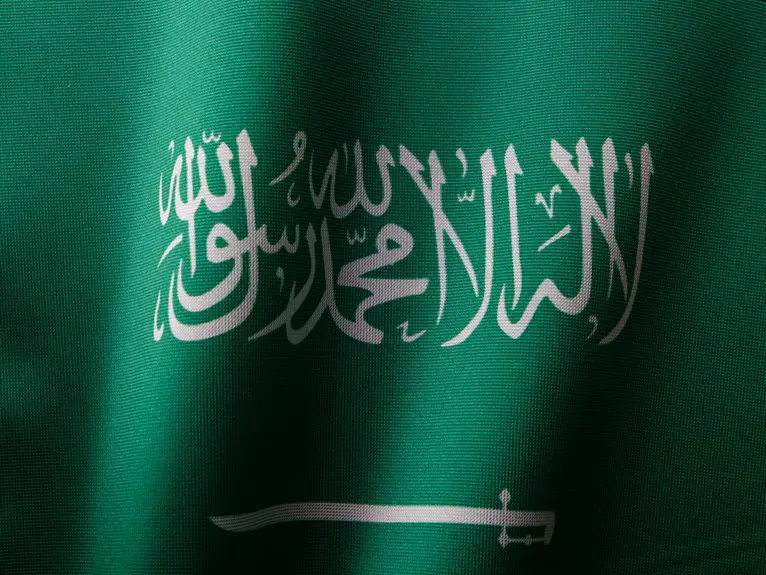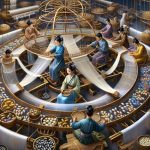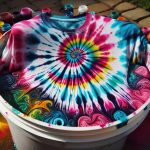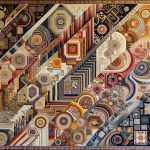You’ll find China Blue dye has deep roots in ancient China, where artisans extracted indigo from native plants to create vibrant, lasting color. This dye symbolized purity and protection, used in traditional fabrics and ceremonial clothing. Its rich history influenced textile trade routes like the Silk Road, spreading its influence globally. Today, China Blue blends heritage with eco-friendly practices and modern fashion. Keep exploring, and you’ll uncover its fascinating cultural legacy and innovative uses.
Table of Contents
Key Takeaways
- China Blue dye originated in ancient China, using indigofera plants for a vibrant, lasting blue pigment symbolizing purity and protection.
- Traditional dyeing involved fermenting indigo leaves and techniques like tie-dye and resist-dyeing to create intricate patterns and deep colors.
- China Blue held cultural significance in Chinese society, featured in ceremonial robes and wedding attire symbolizing immortality and spiritual connection.
- It was a valuable trade commodity along the Silk Road, influencing textile fashion beyond China and facilitating cultural exchanges.
- Modern use includes eco-friendly dyeing methods and digital printing, balancing tradition with sustainability and contemporary design demands.
Origins of China Blue Dye in Ancient China
Although many cultures have developed blue dyes, China Blue‘s origins trace back to ancient China, where artisans mastered the art of extracting vibrant indigo from native plants.
You’d be fascinated to learn that these early craftsmen carefully cultivated indigofera plants, transforming leaves into a rich, lasting pigment.
When you handle China Blue fabric, you’re touching a tradition shaped by centuries of experimentation and skill. The dye wasn’t just a color; it held cultural significance, symbolizing purity and protection.
Traditional Indigo Dyeing Techniques
Several traditional indigo dyeing techniques have been preserved in China Blue fabric-making, each revealing the skill and patience required to achieve its signature hue.
You’ll often start by fermenting indigo leaves to extract the dye, creating a vat rich in natural pigment. Next, you dip the fabric multiple times, allowing it to oxidize between dips, which deepens the blue color.
Techniques like tie-dyeing or resist-dyeing add intricate patterns by preventing dye from reaching certain areas. You might also encounter hand-painting with indigo or block-printing methods, where you apply the dye selectively.
These methods demand precision and timing, as over- or under-dyeing affects the final shade. By mastering these traditional processes, you connect directly with centuries of craftsmanship behind China Blue fabric.
Cultural Significance of China Blue in Chinese Society
The deep blue of China Blue fabric carries rich cultural meaning that goes beyond its striking appearance. When you wear or see this hue, you’re connecting with centuries of Chinese heritage.
This color symbolizes immortality, healing, and protection, often featured in traditional garments and festivals. You’ll find China Blue in wedding attire and ceremonial robes, highlighting its role in marking important life events.
It also reflects the connection between people and nature, as it’s derived from natural indigo plants. By embracing this color, you tap into a shared cultural identity that honors history, craftsmanship, and spiritual beliefs.
China Blue isn’t just a dye; it’s a vibrant thread woven through the fabric of Chinese society.
The Role of China Blue in Textile Trade Routes
When you trace the paths of ancient trade, China Blue stands out as a prized commodity that connected distant cultures. You’ll find that merchants prized this fabric dye for its vibrant color and durability, making it a staple in the Silk Road and maritime routes. As you explore these trade routes, you’ll see how China Blue influenced textile production and fashion in Asia, the Middle East, and Europe.
| Trade Route | Role of China Blue |
|---|---|
| Silk Road | Facilitated cultural and material exchange |
| Maritime Routes | Expanded dye’s reach to coastal markets |
| Trans-Eurasian | Integrated diverse weaving techniques |
Comparison With Other Indigo Dyes Worldwide
As you explore how China Blue traveled along ancient trade routes, you’ll notice it shares similarities and differences with other indigo dyes from around the world.
Like Indian and African indigo, China Blue comes from plants in the Indigofera genus, offering deep, rich blue hues.
However, the Chinese often used a unique fermentation process that gave their dye a distinct brightness and durability.
While Indian indigo gained fame for its intense color and export volume, China Blue’s appeal lay in its subtle tonal variations and integration with traditional weaving techniques.
African indigo, on the other hand, sometimes incorporated local additives, affecting shade and texture.
Understanding these distinctions helps you appreciate China Blue’s unique place in the global history of indigo dyeing.
Methods of Preparing Fabric for China Blue Dye
Before dyeing fabric with China Blue, you’ll need to prepare the material carefully to make certain the color adheres evenly and lasts longer.
Start by thoroughly washing the fabric to remove any oils, dirt, or sizing agents that could block the dye. Then, soak the fabric in water to make certain it’s fully saturated; this helps the dye penetrate uniformly.
Begin by washing fabric thoroughly, then soak it to ensure even dye absorption.
Some traditional methods call for treating the fabric with natural mordants like tannin-rich plant extracts, which enhance dye fixation and deepen the hue.
After mordanting, rinse the fabric gently and let it remain damp before dyeing.
Common Fabrics and Patterns Used With China Blue
Cotton and silk stand out as the most popular fabrics for China Blue dye due to their natural fibers, which absorb the color vividly and hold it well.
When you choose cotton, you get durability and comfort, perfect for everyday wear and household textiles. Silk, on the other hand, offers a luxurious sheen that enhances China Blue’s depth, ideal for more formal garments and decorative pieces.
Common patterns you’ll encounter include intricate floral motifs, geometric shapes, and traditional Chinese symbols like dragons or phoenixes. These patterns are usually created using resist-dyeing techniques, which leave portions of the fabric undyed, creating striking contrasts.
Modern Applications and Innovations in China Blue Dyeing
While traditional fabrics and patterns continue to define China Blue’s heritage, today’s designers and artisans are pushing its boundaries with fresh techniques and uses.
You’ll find China Blue dye integrated into contemporary fashion, home décor, and even digital printing. Innovations have enhanced its vibrancy and durability, making it more versatile than ever.
Here are some modern applications and innovations you can explore:
- Eco-friendly dyeing methods reducing water and chemical use
- Combining China Blue with synthetic fibers for enhanced texture
- Digital pattern printing that replicates traditional motifs precisely
- Fusion with other dyeing techniques for unique color gradients
These advances let you enjoy China Blue in innovative ways while honoring its rich past.
Preservation of Traditional China Blue Dyeing Practices
As you explore the vibrant world of China Blue dye, you’ll find that preserving its traditional methods is essential to maintaining its authenticity and cultural significance.
You can support artisans who still practice hand-dyeing techniques passed down through generations, ensuring these skills don’t disappear. By choosing handmade China Blue fabrics, you help sustain local communities and keep cultural heritage alive.
You might also engage with workshops or cultural events that showcase traditional dyeing processes, deepening your appreciation and understanding. Supporting organizations focused on education and craftsmanship preservation encourages younger generations to learn these time-honored methods.
When you value tradition in China Blue dyeing, you contribute to a living history, safeguarding the unique artistry and stories woven into every indigo-dyed fabric.
Environmental Impact and Sustainability of Indigo Dyeing
Although indigo dyeing has deep cultural roots, it also raises important questions about environmental impact and sustainability. When you consider the process, you’ll realize it involves natural and synthetic methods, each with different consequences.
To minimize harm, you should focus on:
- Using natural indigo from sustainable farming to reduce chemical runoff.
- Employing water-saving techniques during dyeing to conserve resources.
- Avoiding synthetic dyes that often contain toxic substances harmful to ecosystems.
- Supporting artisans who maintain eco-friendly traditions and reduce industrial waste.
Frequently Asked Questions
Can China Blue Dye Be Used on Synthetic Fabrics?
You can’t effectively use China blue dye on synthetic fabrics because it’s designed for natural fibers. If you try dyeing synthetics, the color won’t absorb well or last, so stick to natural materials for best results.
What Are the Health Risks of Handling China Blue Dye?
When handling China Blue dye, you might face skin irritation or allergic reactions. You should always wear gloves and work in a well-ventilated area to avoid inhaling fumes. Don’t let it contact your eyes or open wounds.
How Long Does China Blue Dye Last on Clothing?
Like a deep ocean wave that slowly fades, China Blue dye lasts several washes but won’t stay forever. You’ll notice its vibrant hue soften with time, especially if you wash clothes often or use harsh detergents.
Are There Any Famous Artworks Featuring China Blue Dye?
You’ll find famous artworks like Chinese porcelain and traditional textiles featuring China blue dye. Artists used it for centuries to create stunning blue-and-white designs, showcasing the dye’s vibrant and lasting beauty in various cultural masterpieces.
Can China Blue Dye Be Mixed With Other Colors Safely?
Imagine a painter’s palette where china blue dances with reds or yellows—you can mix them safely, but test first. Colors might shift or dull, so a small trial guarantees your masterpiece stays vibrant and true.
- How Chinese Factories Produce Melt-Blown Non-Woven Fabric - June 20, 2025
- An In-Depth Guide to the China Fabric Market in Keqiao - June 20, 2025
- Sourcing and Working With Linen Fabric Manufacturers in China - June 20, 2025







